Historic Variability of the Water Inflow to the Lazaro Cardenas Dam and Water Allocation in the Irrigation District 017, Comarca Lagunera, Mexico
Abstract
:1. Introduction
2. Materials and Methods
2.1. Study Area
2.2. Hydrometric Records
2.3. Dendrochronological Network
2.4. Development of Reconstruction Model
2.5. Ocean-Atmosphere Phenomena
2.6. Drought Indices
3. Results
3.1. Quality of Tree-Ring Chronologies
3.2. Tree-Ring Chronologies Association and Common Climatic Response
3.3. Relationship between Dendrochronological Series and Water Inflow to the Lazaro Cardenas Dam
- Yi = Annual inflow, X1i, X2i, X3i = Ring-width index (standard version) for the ARN, CBA and COC sites, respectively
3.4. Water Inflow Reconstruction
3.5. Influence of Atmospheric Circulation Patterns
3.6. Influence of Drough Indices
3.7. Dominant Frequencies in the Water Inflow Reconstruction
4. Discussion
5. Conclusions
Author Contributions
Funding
Institutional Review Board Statement
Informed Consent Statement
Data Availability Statement
Conflicts of Interest
References
- Descroix, L.; Nouvelot, J.F.; Vauclin, M. Evaluation of an antecedent precipitation index to model runoff yield in the Western Sierra Madre (North-west Mexico). J. Hydrol. 2002, 263, 114–130. [Google Scholar] [CrossRef]
- Sandoval, S.; Escobar-Flores, J.G.; Sánchez-Ortiz, E. Inventario de cuerpos de agua de la Sierra Madre Occidental (México) usando SIG y percepción remota. Investig. Geográficas 2020, 102, e59975. [Google Scholar] [CrossRef]
- CONAGUA. Estadísticas de los Distritos de Riego, año Agrícola 2013–2014; Comisión Nacional del Agua: Semarnat, México, 2015. Available online: http://www.conagua.gob.mx/conagua07/publicaciones/publicaciones/sgih-6-15.pdf (accessed on 15 April 2021).
- Gochis, D.J.; Brito-Castillo, L.; Shuttleworth, W.J. Hydroclimatology of the North America Monsoon region in northwest Mexico. J. Hydrol 2006, 316, 53–70. [Google Scholar] [CrossRef]
- Pavia, E.G.; Graef, F.; Reyes, J. PDO-ENSO effects in the climate of Mexico. J. Clim. 2006, 19, 6433–6438. [Google Scholar] [CrossRef]
- Seager, R.; Ting, M.; Davis, M.; Cane, M.; Nike, N.; Nakumara, J.; Lie, C.; Cook, E.; Stahle, D.W. Mexican drought: An observational modeling and tree ring study of variability and climate change. Atmosfera 2009, 22, 1–31. [Google Scholar]
- Mendez, M.; Magaña, V. Regional aspects of prolonged meteorological droughts over Mexico and Central America. Am. Meteorol. Soc. 2010, 23, 1175–1188. [Google Scholar] [CrossRef] [Green Version]
- Feng, S.; Hu, Q.; Oglesby, P.J. Influence of Atlantic sea Surface temperature on persistent drought in the North America. Clim. Dyn. 2011, 37, 569–586. [Google Scholar] [CrossRef] [Green Version]
- Meko, D.M.; Touchan, R.; Villanueva, D.J.; Griffin, D.; Woodhouse, C.A.; Castro, C.L.; Leavitt, S.W. Sierra San Pedro Martir, Baja California cool-season precipitation reconstructed from earlywood width of Abies concolor tree rings. J. Geophys. Res. Biogeosci. 2013, 118, 1660–1673. [Google Scholar] [CrossRef]
- Stahle, D.W.; Cook, E.R.; Burnette, D.J.; Villanueva, J.; Cerano, J.; Burns, J.N.; Griffin, D.; Cook, B.J.; Acuña, R.; Torbenson, M.C.A.; et al. The Mexican drought atlas: Tree-ring reconstructions of the soil moisture balance during the late pre-Hispanic, colonial, and modern eras. Quat. Sci. Rev. 2016, 149, 34–60. [Google Scholar] [CrossRef] [Green Version]
- Stahle, D.W.; Cook, E.R.; Burnette, D.J.; Torbenson, M.C.A.; Howard, I.M.; Griffin, D.; Villanueva Diaz, J.; Cook, B.I.; Williams, P.A.; Watson, E.; et al. Dynamics, variability and change in seasonal precipitation reconstruction for North America. J. Clim. 2020, 33, 3173–3195. [Google Scholar] [CrossRef]
- González-Barrios, J.L.; Descroix, L.; Viramontes, D.; Polenard, J.; Plenecassagne, A.; Macías, L.; Boyer, C.; Bollery, A.; Jasso-Ibarra, R. Condiciones que favorecen la erosion y el escurrimiento en manto. In La Sierra Madre Occidental; una fuente de agua amenazada; Descorix, L., González-Barrios, J.L., Estrada-Ávalos, J., Eds.; INIFAP-IRD: Gómez Palacio, Mexico, 2004; pp. 161–178. [Google Scholar]
- Woodhouse, C.A.; Stahle, D.W.; Villanueva Díaz, J. Rio Grande and Rio Conchos water supply variability over past 500 years. Clim. Res. 2012, 51, 125–136. [Google Scholar] [CrossRef]
- Estrada-Ávalos, J.; Villanueva-Diaz, J.; Trucios-Casiano, R. La cuenca del río Nazas en el norte de México: Retos y perspectivas de sus recursos naturales. In Servicios ecosistémicos hídricos: Estudios de caso en America Latina y el Caribe; Lara, A., Laterra, P., Manson, R., Barrantes, G., Eds.; Red Pro Agua CYTED: Valdivia, Chile, 2013; pp. 213–236. [Google Scholar]
- CONAGUA. Agua saludable para la laguna: Captación, potabilización, conducción y almacenamiento de agua potable; Comisión Nacional del Agua: Ciudad de Mexico, Mexico, 2021.
- De la lanza, G.; Carbajal, P.J.L.; Salinas, R.S.A.; Barrios, O.J.E. Medición del caudal ecológico del río Acaponeta, Nayarit, comparando distintos intervalos de tiempo. Investig. Geográficas 2012, 78, 62–74. [Google Scholar] [CrossRef]
- Villanueva, D.J.; Luckman, B.H.; Stahle, D.W.; Therrell, M.D.; Cleaveland, M.K.; Cerano-Paredes, J.; Gutierrez-Garcia, G.; Estrada-Avalos, J.; Jasso-Ibarra, R. Hydroclimatic variability of the upper Nazas basin: Water management implications for the irrigated area of the Comarca Lagunera. Dendrochronologia 2005, 22, 215–223. [Google Scholar] [CrossRef]
- Cleaveland, M.K.; Stahle, D.W.; Therrell, M.D.; Villanueva-Diaz, J.; Burns, B.T. Tree-ring reconstructed precipitation and tropical teleconnections in Durango, Mexico. Clim. Change 2003, 59, 369–388. [Google Scholar] [CrossRef]
- Cerano-Paredes, J.; Villanueva-Diaz, J.; Valdéz-Cepeda, R.D.; Arreola-Ávila, J.G.; Constante-García, V. El Niño Oscilación del Sur y sus efectos en la precipitación en la parte alta de la cuenca del río Nazas. Rev. Chapingo Ser. Cienc. For. Del Ambiente 2011, 17, 207–215. [Google Scholar] [CrossRef]
- Escobar-Pedraza, J.J.; González-Barrios, J.L.; Sánchez-Cohen, I.; Muño-Villallalobos, A.A.; Villa-Castorena, M. Análisis de la lluvia y su relación con cambio climático: Estudio de caso en estación hidrométrica sardinas (San Bernardo, Durango). Rev. Chapingo Ser. Zonas Áridas 2012, 11, 75–84. [Google Scholar]
- Villanueva, J.; Gómez, A.; Cerano, J.; Rosales, S.; Estrada, J.; Castruita, L.U.; Martínez, A.R. La variabilidad del caudal del río Acaponeta inferida mediante series de anillos de crecimiento en coníferas. Tecnol. Cienc. Del Agua 2017, 8, 55–74. [Google Scholar] [CrossRef]
- Torbenson, M.C.A.; Stahle, D.W.; Howard, I.M.; Burnette, D.I.; Griffin, D.; Villanueva-Diaz, J.; Cook, B.I. Drought relief reversal over North America from 1500 to 2016. Earth Interact. 2021, 25, 94–107. [Google Scholar] [CrossRef]
- Magaña-Rueda, V.; Pérez, J.L.; Vázquez, J.L.; Carrizosa, E.; Pérez, J. El Niño y el clima, en Magaña Rueda, V. (Ed.), Los impactos del niño en México, Secretaria de Educación Pública; Consejo Nacional de Ciencia y Tecnología: Mexico City, Mexico, 1999.
- Douglas, M.W.; Maddox, R.A.; Howard, K.; Reyes, S. The Mexican monsoon. Am. Metorolog. Soc. 1993, 6, 1665–1677. [Google Scholar] [CrossRef]
- Adams, D.K.; Comrie, A.C. The North American Monsoon. Bull. Am. Meteorol. Soc. 1997, 78, 2197–2231. [Google Scholar] [CrossRef]
- Higgins, R.W.; Shi, W. Intercomparison of the principal modes of interannual and interseassonal variability of the North American Monsoon System. J. Climate 2001, 14, 403–417. [Google Scholar] [CrossRef]
- Nicholas, R.E.; Battisti, D.S. Drought recurrence and seasonal rainfall prediction in the Río Yaqui Basin, Mexico. J. Appl. Meteorol. Climatol. 2008, 47, 991–1005. [Google Scholar] [CrossRef]
- Garcia-Franco, J.I.; Gray, L.J.; Osprey, S. The American monsoon system in HadGEM3 and UKESM1. Weather. Clim. Dyanamics 2020, 1, 39–371. [Google Scholar] [CrossRef]
- Villanueva-Díaz, J.; Castruita-Esparza, L.U.; Martínez-Sifuentes, A.R.; Loera-Chaparro, R.; Estrada-Ávalos, J. Chihuahua southwestern hydroclimatic variability inferred with coniferous growth rings. Cienc. For. Del Ambiente Chapingo 2020, 26, 373–389. [Google Scholar] [CrossRef]
- Meko, D.M.; Baisan, C.H. Pilot study of latewood-width of conifers as indicator of variability of summer rainfall in the North American Monsoon región. Int. J. Climatol. 2001, 21, 797–7008. [Google Scholar] [CrossRef]
- Stahle, D.W.; Cleaveland, M.K.; Grissino-Mayer, H.D.; Griffin, R.D.; Fye, F.K.; Therrell, M.D.; Burnett, D.J.; Meko, D.M.; Villanueva-Diaz, J. Cool- and warm-season precipitation reconstruction over western New Mexico. J. Clim. 2009, 22, 3729–3750. [Google Scholar] [CrossRef]
- Griffin, D.; Meko, D.M.; Touchan, R.; Leavitt, S.W.; Woodhouse, C. Latewood chronology development for summer-moisture reconstructions in the US Southwest. Tree-Ring Res. 2011, 67, 87–101. [Google Scholar] [CrossRef] [Green Version]
- CONAGUA. Estadísticas del agua en México; Comisión Nacional del Agua: Ciudad de México, Mexico, 2018.
- Woodhouse, C.A.; Gray, S.T.; Meko, D.M. Updated streamflow reconstructions for the Upper Colorado River basin. Water Resour. Res. 2006, 42, W05415. [Google Scholar] [CrossRef]
- Martínez-Sifuentes, A.R.; Villanueva-Díaz, J.; Estrada-Ávalos, J.; Trucíos-Caciano, R.; Carlón-Allende, T.; Castruita-Esparza, L.U. Two Centuries of Drought History in the Center of Chihuahua, Mexico. Forests 2022, 13, 921. [Google Scholar] [CrossRef]
- Bunn, A.G. A dendrochronology program library in r (dplr). Dendrochronologia 2008, 26, 115–124. [Google Scholar] [CrossRef]
- Faraway, J.J. Extending the Linear Model with R: Generalized Linear, Mixed Effects and Nonparametric Regression Models; CRC Press Taylor & Francis Group: London, UK, 2016. [Google Scholar]
- Xia, Y.; Mitchell, K.; Ek, M.; Shefeld, J.; Cosgrove, B.; Wood, E.; Luo, L.; Alonge, C.; Wei, H.; Meng, J.; et al. Continental-scale water and energy flux analysis and validation for the North American Land Data Assimilation System project phase 2 (NLDAS-2): 1. intercomparison and application of model products. J. Geophys. Res. 2012, 117, D03110. [Google Scholar] [CrossRef]
- Stahle, D.W.; Dárrigo, R.D.; Krusic, P.J.; Cleaveland, M.K.; Cook, E.R.; Allan, R.J.; Cole, J.E.; Dunbar, R.B.; Therrell, M.D.; Guy, D.A.; et al. Experimental dendroclimatic reconstruction of the Southern Oscillation. Bull. Am. Meteor. Soc. 1998, 70, 2137–2152. [Google Scholar] [CrossRef]
- Wolter, K.; Timlin, M.S. Monitoring ENSO in COADS with a seasonally adjusted principal component index. In Proceedings of the 17th Climate Diagnostics Workshop, Norman Oklahoma, NOAA/NMC/CAC, NSSL, Oklahoma Climate Survey CIMMS—School of Meteorology of the University of Oklahoma, Norman, OK, USA, 19–23 October 1992. [Google Scholar]
- Wright, P.B. Persistence of rainfall anomalies in the Central Pacific. Nature 1979, 277, 371–374. [Google Scholar] [CrossRef]
- Mantua, N.J.; Hare, S.R.; Zhang, Y.; Wallace, J.M.; Francis, R.C. A Pacific interdecadal climate oscillation with impacts on salmon production. Bull. Am. Meteorol. Soc. 1977, 78, 1069–1079. [Google Scholar] [CrossRef]
- Tarik, C.G.; Aslak, G.; Viliam, S. R Package “Biwavelet”: Conduct Univariate and Bivariate Wavelet Analyses. 2017. Available online: https://github.com/tgouhier/biwavelet (accessed on 16 May 2022).
- Speer, J. Fundamentals of Tree-Ring Research; University of Arizona Press: Tucson, AZ, USA, 2010. [Google Scholar]
- Draper, N.R.; Smith, H. Applied Regression Analysis, 2nd ed.; Wiley: New York, NY, USA, 1981. [Google Scholar]
- Fritts, H. Tree Rings and Climate; Academic Press: London, UK; New York, NY, USA, 1976. [Google Scholar]
- Fritts, H.C.; Joel, G.; Gordon, G.A.; Schweingruber, F. Methods of Calibration, Verification, and Reconstruction; Springer: Dordrecht, The Netherlands, 1990. [Google Scholar]
- van Oldenborgh, G.J.; te Raa, L.A.; Dijkstra, H.A.; Philip, S.Y. Frequency- or amplitude-dependent effects of the Atlantic meridional overturning on the tropical Pacific Ocean. Ocean. Sci. 2009, 5, 293–301. [Google Scholar] [CrossRef] [Green Version]
- Guztler, D.S. An index of interanual precipitation variability in the core of the North American Monsoon Region. J. Clim. 2004, 17, 4473–4480. [Google Scholar]
- Meko, D.M.; Stockton, C.W.; Bogges, W.R. The tree-ring record of severe sustained drought. Water Resour. Bull. 1995, 31, 789–801. [Google Scholar] [CrossRef]
- Woodhouse, C.; Lukas, J.L. Multi-century tree-ring reconstructions of Colorado streamflow for water resource planning. Clim. Change 2006, 78, 293–315. [Google Scholar] [CrossRef]
- Case, R.A.; McDonald, G.M. Tree ring reconstruction of streamflow for three Canadian prairie rivers. J. Am. Water Resour. Asoc. 2003, 39, 703–716. [Google Scholar] [CrossRef]
- Ferrero, M.E.; Villalba, R.; de Membiela, M.; Hidalgo, L.F.; Luckman, B.H. Tree-ring based reconstruction of rio Bermejo streamflow in sutropical South America. J. Hydrol. 2015, 525, 572–584. [Google Scholar] [CrossRef]
- Martínez-Sifuentes, A.R.; Villanueva-Díaz, J.; Carlón-Allende, T.; Estrada-Avalos, J. 243 years of reconstructed streamflow volume and identification of extreme hydroclimatic events in the Conchos River Basin, Chihuahua, Mexico. Trees 2020, 34, 1347–1361. [Google Scholar] [CrossRef]
- D’Arrigo, R.; Nerilie, A.; Ummenhofer, C.; Palmer, J.; Mudelsee, M. Reconstructed streamflow for Citarum River, Java, Indonesia: Linkages to tropical climate dynamics. Clim. Dyn. 2011, 36, 451–462. [Google Scholar] [CrossRef]
- Genç, S.; Güner, H.T. Precipitation and Streamflow Reconstructions from Tree Rings for the Lower Kızılırmak River Basin, Turkey. Forests 2022, 13, 501. [Google Scholar] [CrossRef]
- Castruita-Esparza, L.U.; Correa-Díaz, A.; Gómez-Guerrero, A.; Villanueva-Díaz, J.; Ramírez-Guzmán, M.E.; Velázquez-Martínez, A.; Ángeles-Pérez, G. Basal area increment series of dominant Pseudotsuga menziesii (Mirb.) Franco show periodicity according to global climate patterns. Rev. Chapingo Ser. Cienc. For. Del Ambiente 2016, 22, 379–397. [Google Scholar] [CrossRef] [Green Version]
- Cerano-Paredes, J.; Villanueva-Díaz, J.; Valdéz-Cepeda, R.D.; Arreola-Ávila, J.G.; Constante-García, V. Effect of the El Niño Southern Oscillation on Precipitation in the Upper Nazas River Watershed; Revista Chapingo, Serie Ciencias Forestales y del Ambiente 2011; Special Publication: Texcoco, Mexico, 2011; Volume XVII, pp. 207–215. [Google Scholar]
- Englehart, P.J.; Douglas, A.V. Mexico’s summer rainfall patterns: An analysis of regional modes and changes in their teleconnectivity. Atmosfera 2002, 15, 147–1614. [Google Scholar]
- Stahle, D.W.; Villanueva-Diaz, J.; Burnette, D.J.; Cerano-Paredes, J.; Heim, R.R., Jr.; Fye, F.K.; Acuna-Soto, R.; Therrell, M.D.; Cleaveland, M.K.; Stahle, D.K. Major Mesoamerican droughts of the past millennium. Geophys. Res. Lett. 2011, 38, L05703. [Google Scholar] [CrossRef]
- Liu, Y.; Song, H.; An, Z.; Sun, C.; Trouet, V.; Cai, O.; Liu, R.; Leavitt, S.; Song, Y.; Li, Q.; et al. Recent anthropogenic curtailing of Yellow River runoff and sediment load is unprecedented over the past 500 y. Proc. Natl. Acad. Sci. USA 2020, 117, 18251–18257. [Google Scholar] [CrossRef]
- Hertweijer, C.; Seager, R.; Cook, E.R.; Emile-Geay, J. North American Droughts of the Last Millennium from a Gridded Network of Tree-Ring Data. J. Clim. 2007, 20, 1353–1376. [Google Scholar] [CrossRef] [Green Version]
- Ren, H.; Scaife, A.; Dunstone, N.; Tian, B.; Liu, Y.; Ineson, S.; Lee, J.; Smith, D.; Liu, C.; Thompson, V.; et al. Seasonal predictability of winter ENSO types in operational dynamical model predictions. Clim. Dyn. 2019, 52, 3869–3890. [Google Scholar] [CrossRef]
- World Bank Group. Climate Change Knowledge Portal for Development Practitioners and Policy Makers. 2021. Available online: https://climateknowledgeportal.worldbank.org/country/mexico/climate-data-projections (accessed on 7 July 2022).
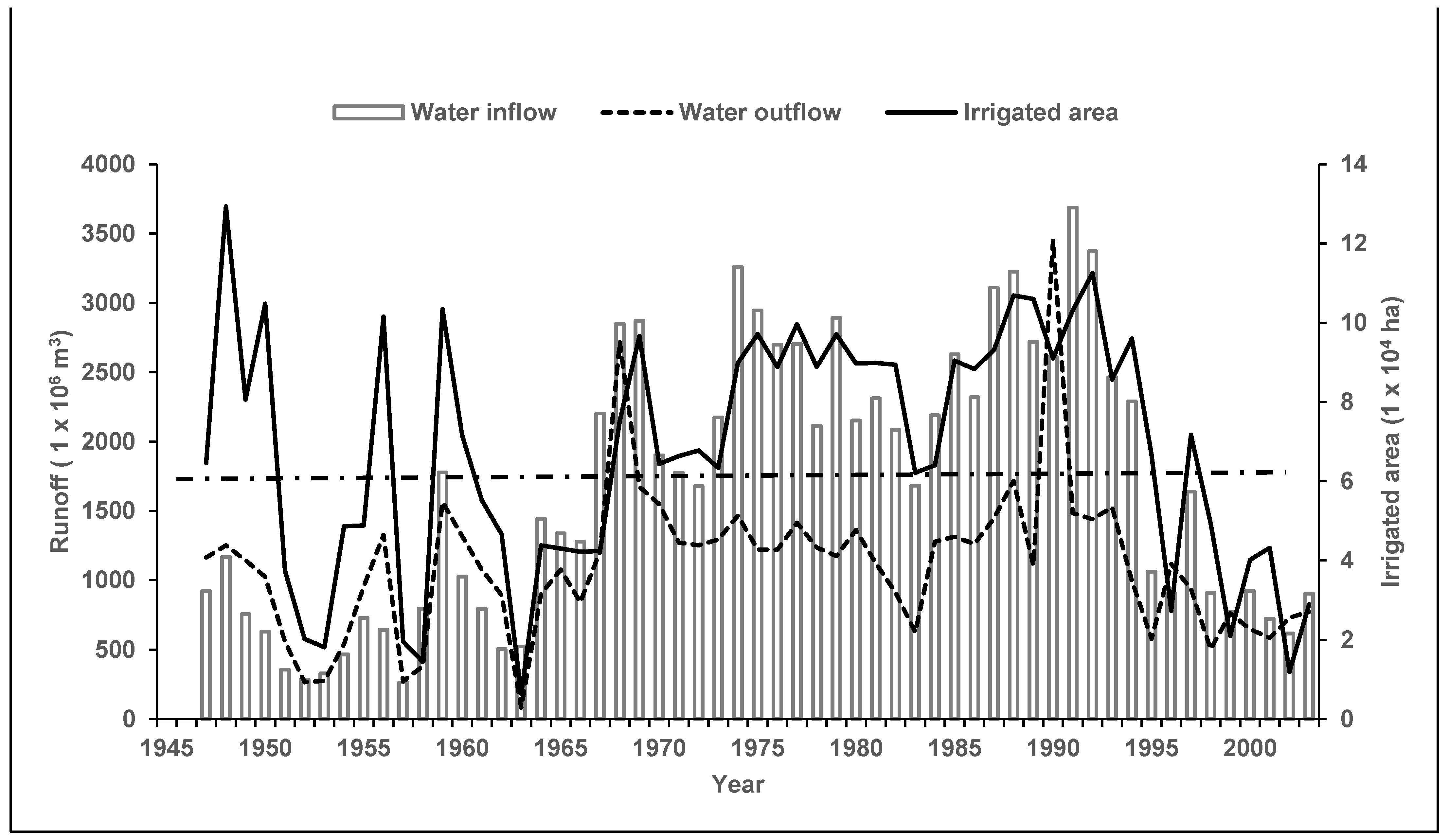
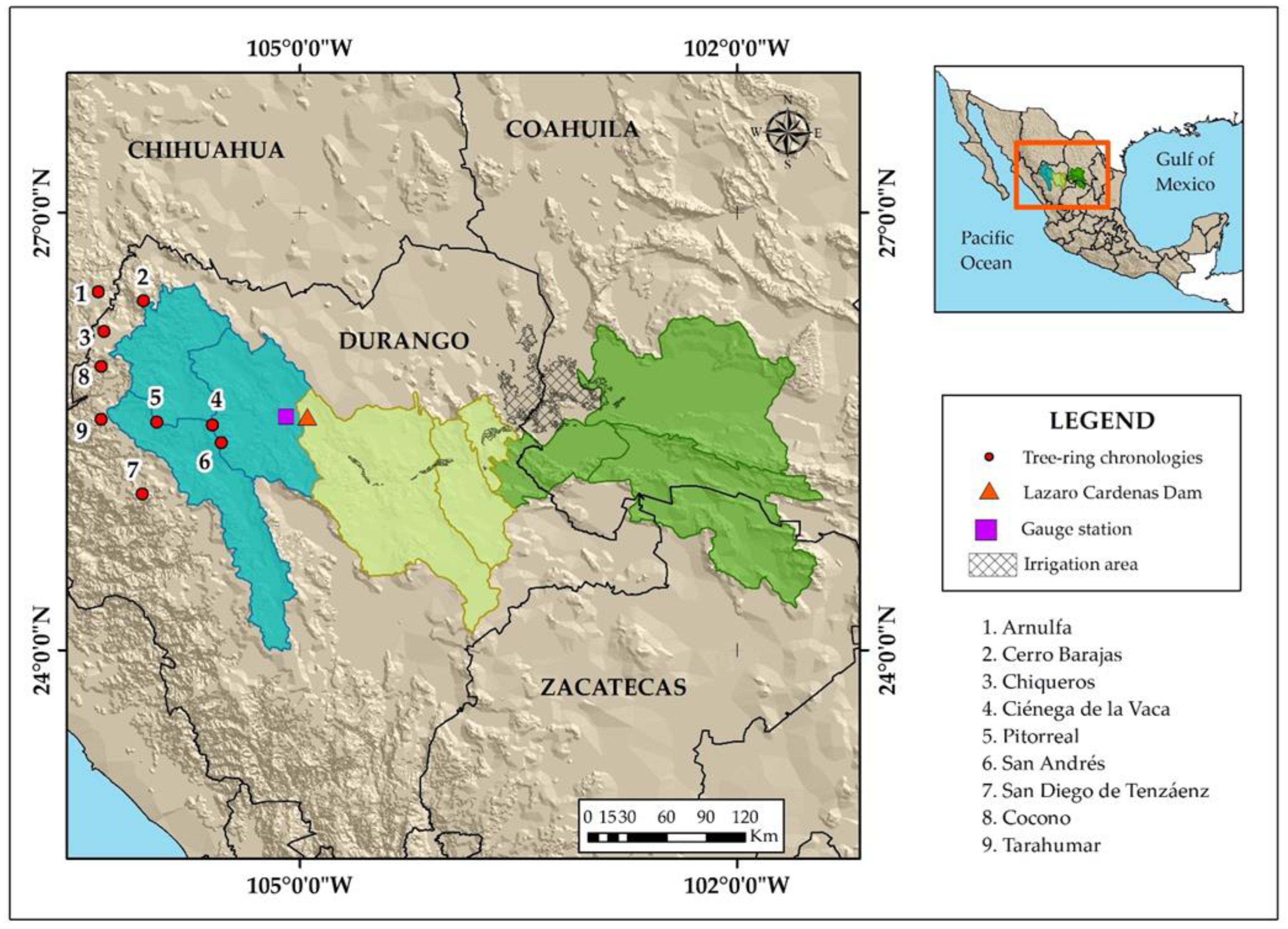


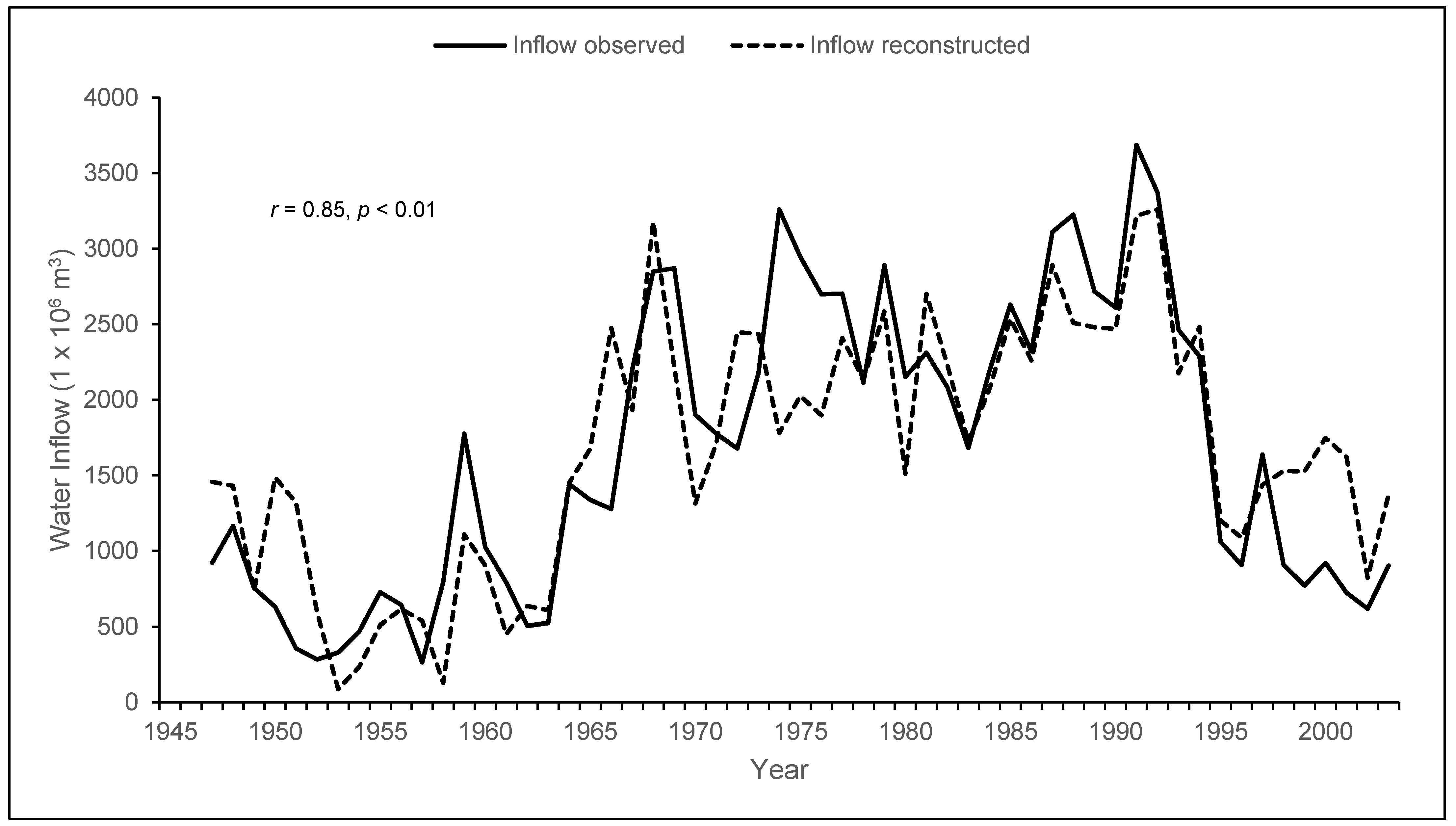

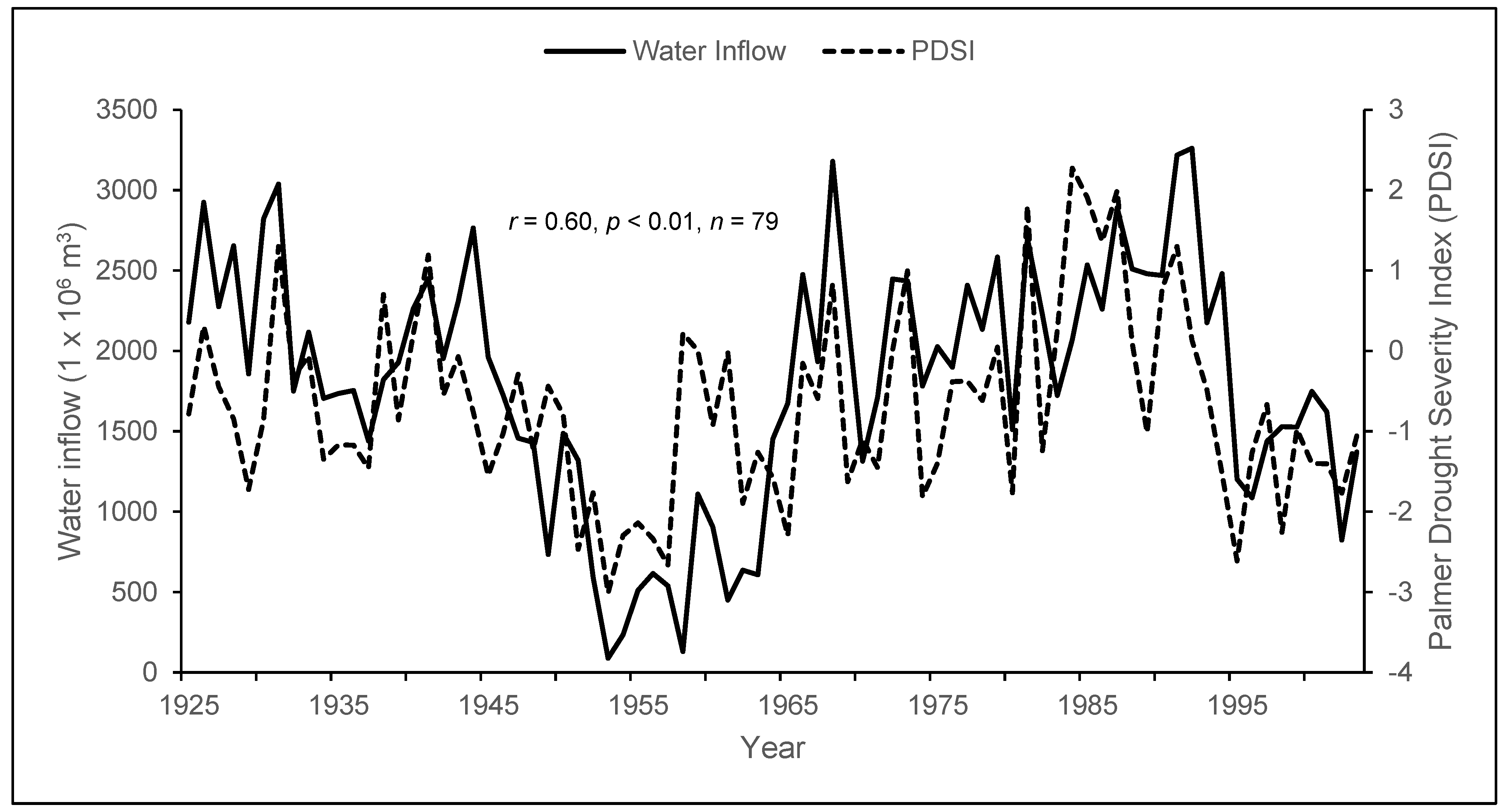
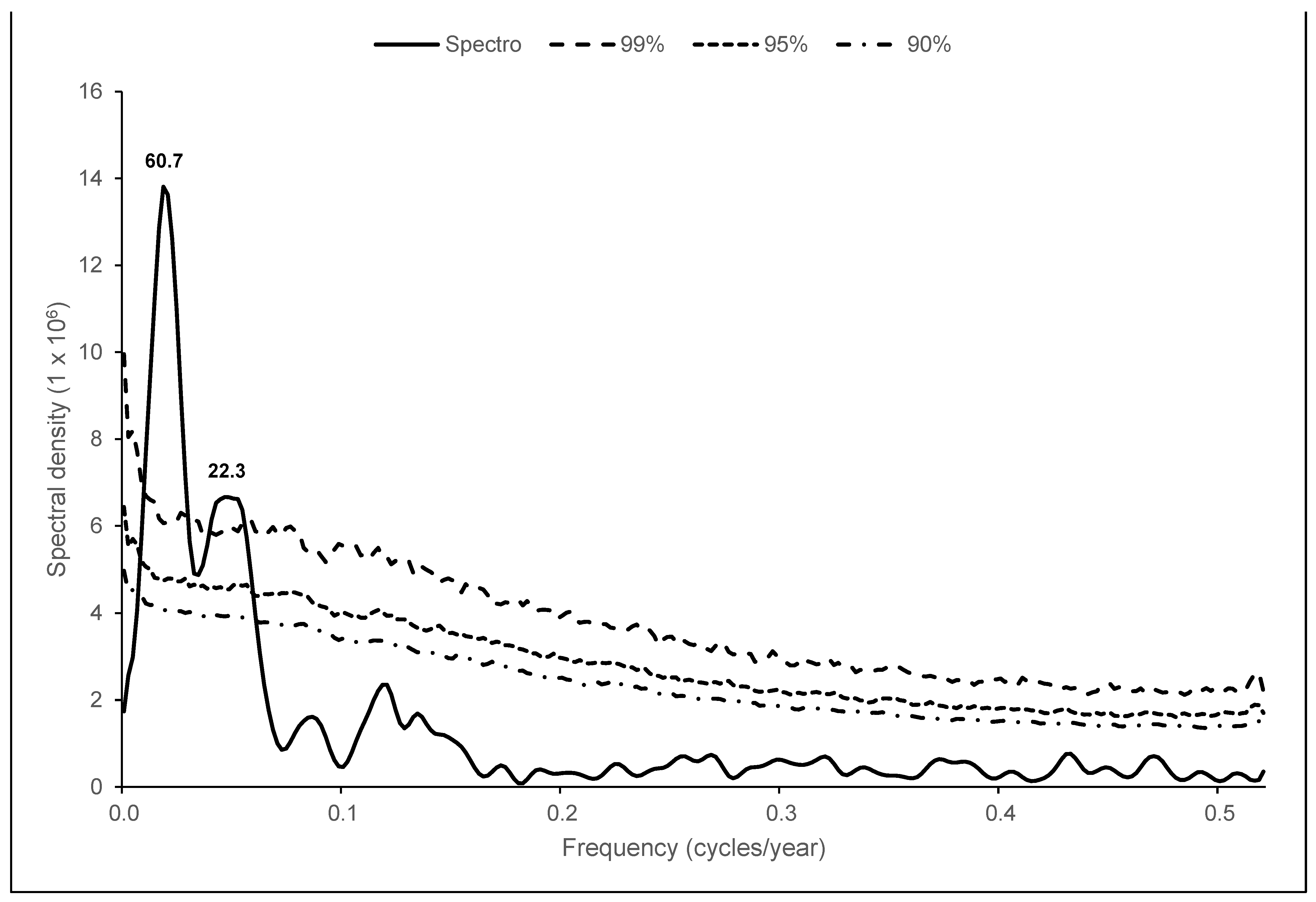

| Site Chronology | 1 SP | Time Period | No. Trees | 2 SI | 3 AMS | 4 Rbar | 5 CE | 6 EPS | 7 SNR |
|---|---|---|---|---|---|---|---|---|---|
| Arnulfa (ARN) | Pc | 1753–2011 | 34 | 0.62 | 0.20 | 0.49 | 1.20 | 0.95 | 18.49 |
| Cerro Barajas (CBA) | Pm | 1510–2009 | 47 | 0.70 | 0.30 | 0.52 | 3.35 | 0.94 | 16.32 |
| Chiqueros (CHI) | Pm | 1418–2005 | 48 | 0.70 | 0.24 | 0.47 | 1.32 | 0.95 | 17.06 |
| Pitoreal (PIT) | Pm | 1693–2003 | 44 | 0.76 | 0.32 | 0.58 | 1.61 | 0.97 | 30.05 |
| Cienega de la Vaca (CVA) | Pm | 1763–2003 | 23 | 0.71 | 0.36 | 0.56 | 1.42 | 0.93 | 13.98 |
| San Andres (SAN) | Pm | 1709–2004 | 43 | 0.75 | 0.41 | 0.58 | 1.52 | 0.96 | 22.09 |
| San Diego de Tenzaenz (SDT) | Pm | 1777–2004 | 43 | 0.64 | 0.24 | 0.45 | 1.54 | 0.94 | 16.94 |
| Cocono (COC) | Pm | 1460–2003 | 69 | 0.70 | 0.28 | 0.51 | 1.44 | 0.96 | 24.20 |
| Tarahumar (TAR) | Pm | 1724–2003 | 44 | 0.70 | 0.28 | 0.51 | 1.79 | 0.95 | 19.89 |
| Inflow (1 × 106 m3) | Period | Ring-Width Chronologies, Standard Version | ||||||||||
|---|---|---|---|---|---|---|---|---|---|---|---|---|
| PC1 | PC2 | ARN | CBA | CHI | CVA | PIT | SAN | SDT | COC | TAR | ||
| LCD | 1947–2003 | 0.75 ** | −0.44 ** | 0.82 ** | 0.52 ** | 0.41 ** | 0.46 ** | 0.24 | 0.15 | 0.22 | 0.29 * | 0.31 * |
| Model | R2 | R2Adj 1 | AIC | logLik | F-Statistic | Residual Standard Error |
|---|---|---|---|---|---|---|
| PC model (PC1 + PC2) | 0.68 | 0.66 | 889.1 | −440.2 | 55.97 | 561.3 |
| Pooled model (all 9 sites) | 0.72 | 0.68 | 895.3 | −435.2 | 15.91 | 546.1 |
| Stepwise model | 0.73 | 0.70 | 883.6 | −436.2 | 44.68 | 528.6 |
| Period | R2Adj 1 | Coefficient (mm) | Standard Error (mm) | Regression (Prob.) | ||||
|---|---|---|---|---|---|---|---|---|
| ARN | CBA | COC | ARN | CBA | COC | |||
| 1947–1980 | 0.61 | 2807.4 ** | 1511.0 * | −1758.9 * | 704.6 | 760.6 | 663.3 | 0.000 ** |
| 1981–2003 | 0.81 | 4771.8 ** | 716.6 * | −1599.7 ** | 537.8 | 509.7 | 553.5 | 0.000 ** |
| 1947–2003 | 0.70 | 3431.1 ** | 466.6 | −1344.2 | 399.0 | 470.9 | 466.6 | 0.000 ** |
| Period | 1 r | 2 RE | 3 ST | 4 RMSE |
|---|---|---|---|---|
| 1981–2003 | 0.91 * | 0.78 * | 24 * | 428.29 * |
| 1947–1980 | 0.80 * | 0.63 * | 34 * | 564.12 |
| Subperiod | Mean (1 × 106 m3) | Standard Error | Median (1 × 106 m3) | Standard Deviation (1 × 106 m3) | Minimum Volume (1 × 106 m3) | Maximum Volume (1 × 106 m3) |
|---|---|---|---|---|---|---|
| 1753–1802 | 1818.2 | 92.5 | 1812.3 | 653.8 | 227.0 | 3029.5 |
| 1803–1852 | 1829.0 | 86.6 | 1847.6 | 612.0 | 139.7 | 2817.6 |
| 1853–1902 | 1744.4 | 62.0 | 1744.4 | 438.7 | 837.9 | 2624.5 |
| 1903–1952 | 2039.2 | 76.9 | 2047.6 | 543.7 | 592.2 | 3039.7 |
| 1953–2002 | 1739.5 | 119.2 | 1764.6 | 843.1 | 88.1 | 3260.3 |
| Period | Water Inflow (<1650.5 × 106 m3) | >1650.5 × 106 m3 but <2355.2 × 106 m3 | >2355.2 × 106 m3 | |||
|---|---|---|---|---|---|---|
| Number of Years | % | Number of Years | % | Number of Years | % | |
| 1947–2006 (recorded) | 28 | 49 | 14 | 25 | 15 | 26 |
| 1753–2003 (reconstructed) | 91 | 36 | 105 | 42 | 55 | 22 |
| Index | Seasonal Period | Period (Years) | Pearson Correlation Coefficient (p-Value) |
|---|---|---|---|
| 1 SOI Rec. | Dec–Feb | 1753–1977 (225) | −0.24 (0.0003) |
| 2 MEI | Jan–Dec | 1871–2003 (133) | 0.25 (0.0004) |
| 3 TRI | Oct–Mar | 1894–1995 (102) | 0.28 (0.0039) |
| 4 PDO | Jul–Oct | 1948–2003 (56) | 0.30 (0.0250) |
| 5 AMO | Oct–Mar | 1857–2003 (155) | −0.43 (0.0000) |
| 6 NAMS | 5 Jul–15 Sep | 1951–1998 (48) | 0.48 (0.0005) |
| 7 PDSI | Jun–Aug | 1901–2003 (103) | 0.54 (0.0000) |
Publisher’s Note: MDPI stays neutral with regard to jurisdictional claims in published maps and institutional affiliations. |
© 2022 by the authors. Licensee MDPI, Basel, Switzerland. This article is an open access article distributed under the terms and conditions of the Creative Commons Attribution (CC BY) license (https://creativecommons.org/licenses/by/4.0/).
Share and Cite
Villanueva-Díaz, J.; Estrada-Ávalos, J.; Martínez-Sifuentes, A.R.; Correa-Díaz, A.; Meko, D.M.; Castruita-Esparza, L.U.; Cerano-Paredes, J. Historic Variability of the Water Inflow to the Lazaro Cardenas Dam and Water Allocation in the Irrigation District 017, Comarca Lagunera, Mexico. Forests 2022, 13, 2057. https://doi.org/10.3390/f13122057
Villanueva-Díaz J, Estrada-Ávalos J, Martínez-Sifuentes AR, Correa-Díaz A, Meko DM, Castruita-Esparza LU, Cerano-Paredes J. Historic Variability of the Water Inflow to the Lazaro Cardenas Dam and Water Allocation in the Irrigation District 017, Comarca Lagunera, Mexico. Forests. 2022; 13(12):2057. https://doi.org/10.3390/f13122057
Chicago/Turabian StyleVillanueva-Díaz, José, Juan Estrada-Ávalos, Aldo Rafael Martínez-Sifuentes, Arian Correa-Díaz, David M. Meko, Luis Ubaldo Castruita-Esparza, and Julián Cerano-Paredes. 2022. "Historic Variability of the Water Inflow to the Lazaro Cardenas Dam and Water Allocation in the Irrigation District 017, Comarca Lagunera, Mexico" Forests 13, no. 12: 2057. https://doi.org/10.3390/f13122057





